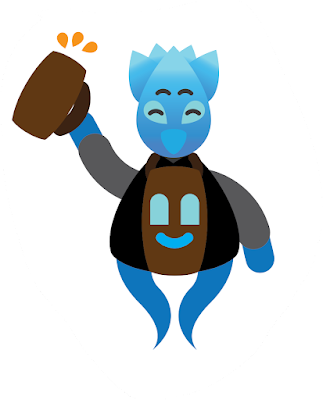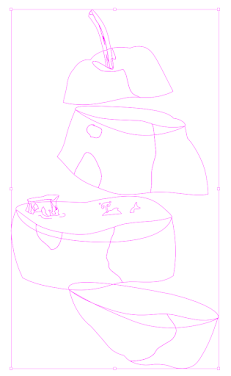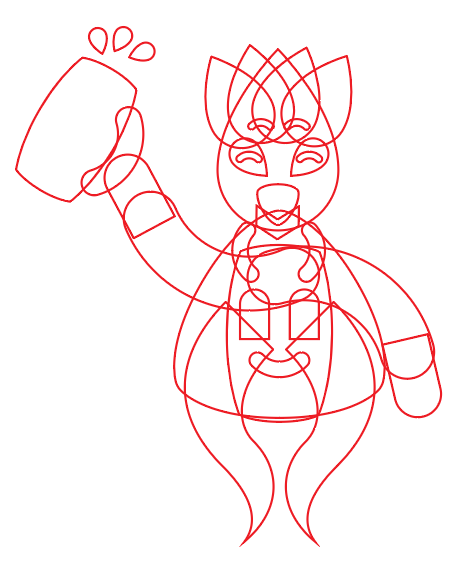Illustration and Visual Narrative | Task 1
Week 1 - Week 4 (25/9/2023 - 23/10/2023)
Melvin Yung Khun Yew | 0357241 |
Bachelor of Design (Hons) in Creative Media
COM 61304 Illustration and Visual Narrative
Task 1
This portfolio consists of:
Click on the link to jump to that part of the portfolio
Lectures
↑↑↑ Back to top ↑↑↑

|
| Outlining circle |

|
| Outlining a car using 12 nodes |
Week 2: Character Design Basics
Stylized Design
- Iconic
- Simplicity
- Unique
The principle of character design
-
Shapes
Shapes design a character's silhouette to identify a character from one another

|
| Monster Inc. © Pixar, 2001 |
The shapes can add some weight to their personality

|
| Aladdin © Disney, 1992 |
-
Colour
Colour can be used to establish the basic roles of the characters by determining and separating the
basic characteristics of heroes, villains and even background characters.
Colour can even determine psychology by giving out impressions of different emotions.Star Wars Franchise © Disney
Inside Out © Pixar, 2015
-
Emphasis & Contrast
These principles are used for exaggeration to memorate
Colours and shapes are often emphasized and contrasted in a good character design to make them stand outTangled © Pixar, 2010 Inside Out © Pixar, 2015
-
Harmony
Every element (shapes, colours, motifs, patterns) in the design should complement each other
Visual hierarchy and how it reflects the narrative of the characters
Inside Out © Pixar, 2015
-
Expression and poses
Clear visualization expressions (behaviours, quirks, personalities) are important for easier visual appeal to viewers
Inside Out © Pixar, 2015
Week 3: Chiaroscuro
What is chiaroscuro?
- The use of light and dark creates the illusion of
three-dimensional volume on a flat surface.
- Tonal contrast
The purpose of chiaroscuro:
- To increase the scene's dramatic tension by exaggerating the subject's importance using colour or light contrast.
- To create a sensational effect that helps elevate fantastical viewpoints to emphasise the narrative.
- To attract attention by establishing visual hierarchy, the main point of a scene.
- To make the tasteful composition when negative spaces and positive spaces are used to create attractive scenes
References and video suggestions:

Adobe Tools Exercise:
Pencil Tool (Shortcut: N)
Pathfinder (Divide)
Homework for Week 3: Shadows of anything you favour and cast in on the pear
After careful consideration, I decided to use the portrait photo of a woman in the chiaroscuro exercise folder in Google Classroom and cast the shadows on the pear.

|
| Original woman portrait photo |

|
|
Outlining and shadow selection using pen tool |

|
| Base colour selection of pear |

|
| Finished work |

|
| Trace out the outline of the targeted man |
The next step is to compound all the shadows into a single compound path in Object > Compound Path (Adobe Illustrator)

|
|
Clipping mask of pattern on the shadow |

|
| Background darkening to see the details better |
Instructions
↑↑↑ Back to top ↑↑↑
The first task will be exercises that aid and benefit me in gaining theoretical and practical knowledge in illustration and visual narrative to inform and provide me with the necessary experience to take on this module.
Daily in-class technical exercises
- Generate and communicate design concepts and solutions through manual and digital skills effectively and skillfully.
- Use creative thinking skills and methodologies to explore, generate and test a wide range of conceptual ideas.
- Use information and communication technology to source navigate, select, retrieve and manage information.
Work Process
↑↑↑ Back to top ↑↑↑

|
| Vormator Challenge: Shapes |
Using the shapes, I have decided to create a character that portrays a good person's characteristics with the character shape language in mind.

|
|
The Walt Disney: Shape Language |
Circles and triangles are the main base shapes of my character, as I want to bring kindness and reliable characteristics into it. Here is my first attempt at the character design:

|
| Fig 1.1 Hydro Person Design Ver 1.0 — 6/10/2023 |
I went with the hydro character design to further strengthen the personality of friendly as we know that the water H2O is harmless to us. Thus blue colour becomes the main tone of my character.
- Curly hair-like design
- Tongue with darker blue colour
- Fine textures and details on the beer tankard
- Legs and shoes
- More detailed hands
- Colour change of the icon on leather aprons

|
| The first version of the game card design |
As I was not satisfied with the first version of the background design, I decided to change the background of the game card based on the medieval tavern as the character is holding a tankard.
Feedback
↑↑↑ Back to top ↑↑↑
Reflection
↑↑↑ Back to top ↑↑↑
-
Experiences
Even though this Illustration and Visual Narrative class are being conducted online through Microsoft Teams every Monday, I am still able to feel the fun of this module with every lecture and the information I received throughout these 6 weeks of class. Despite this module seems easy on paper, the sheer amount of effort and time one needs to put into it surprised me especially when I was doing this first task. Character design with limited elements and materials really put my knowledge and skill applications to the test.
-
Observation
In my spare time, sometimes I look up on Pinterest watching and admiring other professionals' work. The amount of knowledge and time they put into their work is what I can't imagine. Moreover, Mr Hafiz patiently taught and guided us on the features and functions of Adobe Illustrator, I believe I can see a better version of myself compared to when I was still in the Foundation in Design course at Taylor's College.
-
Findings
I found a lot of cool info that piqued my interest in how to create a successful character design during these 5 weeks of lectures and the practical use of them throughout this first task that requires me to develop a character from scratch. From the principles of character design to the visual effects to further portray moods in scenes, I can get to touch on these pearls of wisdom thanks to the lecturing from Mr Hafiz Zamri.



































Comments
Post a Comment